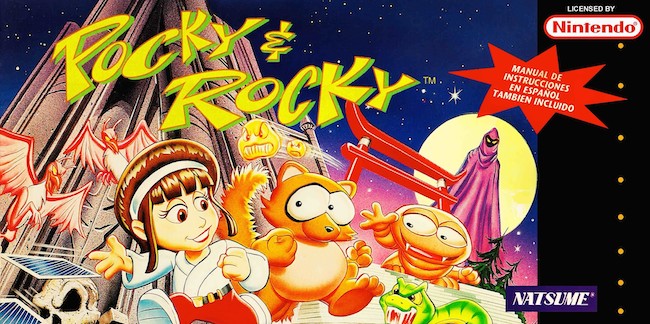
Back in the day, you’d probably be forgiven for passing by such an oddball title. I mean, look at the boxart – what the hell is even going on in this game? It’s got some androgynous, card-lobbing Gi-clad oddball running alongside an overgrown Tanuki surrounded by some very specific Japanophilic iconography. However, for those who couldn’t get to the video shop fast enough to snag a copy of TMNT: Turtles in Time or Super Mario Kart for the weekend might have found themselves in for an unexpected treat when they whacked this sucker into their SNES.
Pocky and Rocky took the best elements of popular arcade shooters, and transposed them into a console title with integrity to the source while adding in the necessary concessions and courtesies of home console play (such as infinite continues, and a simple enough power-up tree). The gameplay is a simple enough overhead shooter, but is rounded off with surprisingly tight controls, and two-player co-op that’ll suit novices, right up to the master fighters. Quite a bit of strategic fare was worked into the design of Pocky and Rocky; both playable characters, while handling identically, have some slight differences: Pocky (the shrine maiden) has a defensive charge move which involves her spinning (and still mobile) with a wand extended for several seconds, deflecting all enemy projectiles away (deflected projectiles can damage enemies), though she is vulnerable to melee attacks. Additionally, Pocky’s powerbomb is more powerful, but only affects enemies cardinally aligned with her. Rocky (the Tanuki), has a defensive charge move that turns him into a statue for several seconds; where he deflects all projectiles and is completely impervious to damage, but is immobilised. Rocky’s powerbomb is less powerful but affects all areas of the screen evenly. Each playable character is also equipped with a fast ‘dash’ move which functions as a quick evasive maneuver.
Graphically, it’s quite a treat with chunky, colourful graphics and quirky, culturally misplaced weirdness (as a kid, I always thought the zombies in the Graveyard level looked like undead surfers, complete with dreadlocks and board shorts). If you’re looking for an unusual, but immensely fun old-school co-op shooter, check out Pocky and Rocky!

This run and gun shooter is a great example of a game that didn’t get the attention it deserved upon released. It made an appearance on both the Sega Mega Drive and Super Nintendo, but, in fact, the SNES port is the more definitive version with crisper graphics and better sound. The aim of Zombies Ate My Neighbors is very straightforward. You take control of either Zeke or Julie, and the mission is to find and rescue ten helpless neighbours before the zombies and other creatures get their undead hands on them. You’re armed with a holy water pistol to take down the basic enemies, but eventually pickup high-powered weapons from bazookas to dynamite to defeat stronger enemies. When you manage to save enough neighbours, an exit door will open up and transport you to the next stage.
The gameplay is pretty easy to pickup, and the huge array of weapons gives you plenty to work with. The game does start out fairly easy and might feel like a breeze at first, but the difficulty picks up quite fast in later stages as monsters become harder to defeat and neighbours more troublesome to save. The overall presentation is fantastic and has a cheesy B-movie feel about it. Everything about this game is so spot on that I wouldn’t change a thing! Unique character design, fun soundtrack, challenging levels, and an excellent co-op mode. Zombies Ate My Neighbors is a worthy retro title to track down if you feel like saving your neighbourhood and wasting zombies away in a 16-bit realm.

Ah, Doshin the Giant, such a bizarre and wonderful gaming gem that many Australians would’ve missed due to the lack of a local release. Originally released as a 64DD title in Japan, it was updated and re-released for the Nintendo GameCube in 2002; years later, in 2011, a friend of mine would dig it out of his retro collection, putting it then into the console, but forever into my heart. You take up the role of Doshin, the loving, smiling, yellow giant with an unfortunately placed belly button, and change the landscape to help the villagers who live there. You could also be Jashin if you prefer, his evil, red, winged alter ego, because no God Sim is complete without the ability to torment and destroy the tiny creatures whose lives you’ve shanghaied.
There are objectives and goals in the game, though you’d be forgiven for missing them; the game has a small translation problem that ranges from the minor and forgivable to hilarious and completely misleading. Even the on-screen script is often out of step with what’s being said, and almost all of the dialogue in the game is also delivered to you by this dude right here. Some might call him “pants sh***ingly terrifying,” especially when he speaks with a voice that resembles David Attenborough’s, but I feel as though it just adds to the games charm. Since he isn’t very useful, however, and without an obscene amount of trial and error, it’ll be a good long while before you cotton on to actually how you beat the game. At this point, you’ll likely get frustrated, revert to Jashin, and start murdering everyone on the island. On the flip side, though, this part of the game is actually really fun. Plus you’ll be, like, really tall, and Jashin can jump super high when he’s tall. Best game ever. Ten out of ten.
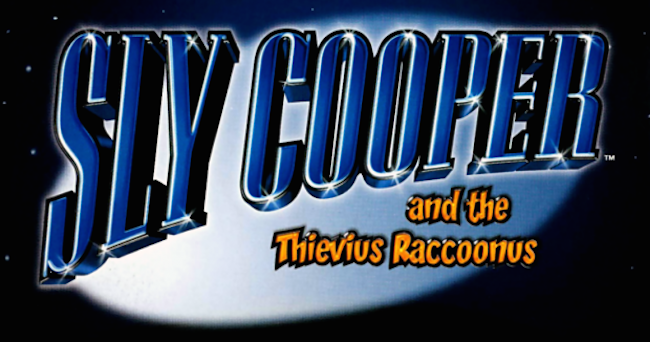
If you were a PlayStation gamer during the PS2 era, then chances are Ratchet, Clank, Jak, and Daxter were your best friends. You might have had real friends, but I can only speak from my own experience. There was a third mascot platformer on Sony’s second console, though: Sly Cooper. Sly Raccoon and The Thievius Raccoonus was my first PS2 game, and still holds a warm, furry place in my heart. I love the Ratchet & Clank games to this day, too, and I had a bunch of fun with Jak and Daxter when they were around, but I never felt that Sly got the recognition he deserved.
Years later, the original trilogy came to the PS3, as well as a fourth entry in the series. After this, Sly’s relevance in the platforming ecosystem was inflated to an appropriate size in my eyes. However, there’s still so much credit I feel my stealthy raccoon buddy is owed, if only for how ahead of the times he was. Plotting heists years before GTA V and stealing wonderful treasures before Nathan Drake was in diapers. Hell, Sly was exploring the verticality of cities, mastering parkour, trailing victims from rooftops, learning abilities from his family line, and utilizing disguises and gadgets long before any of Altair’s descendants. Great characters, rewarding and interesting platforming, good looking environments, and well designed levels were staples of the Sly Cooper trilogy. An arguably stronger trait of the series, though, is its capability to appeal to any age group. Obviously, there are people out there who wouldn’t touch a colourful game with anthropomorphic characters because anything straying from battlefields and firearms is below them, but as much as I loved the series as a child, I can still appreciate it in new ways years later.
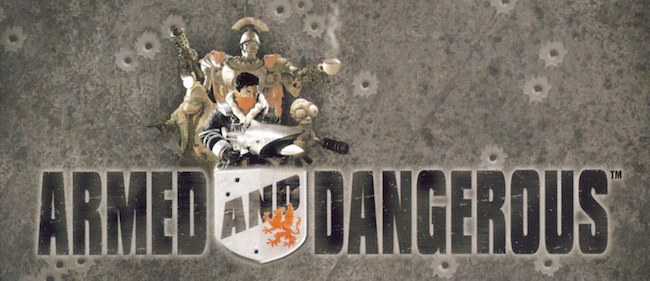
Armed and Dangerous is one of those games that you didn’t know you wanted to play until you played it. It’s this nonsensical, ridiculous, and all the while satisfyingly fun game that nails just about everything it tries to do. And yet, for some reason, no one seems to have played it apart from a handful of demented individuals who gravitated towards shark guns and satire. I suppose that’s the best descriptor of this game: Demented, but in a good way.
The story revolves around Roman, a Robin Hood who loves guns, as he fulfils his destiny alongside a 12-foot tall steampunk robot, Q, a stubby mole with a tendency to pessimism, Jonesy, and a knee-high blind man with an oversized glass eye, Rexus. Together, they bring down the king of the land and his… Uh… Less than intelligent son. You also kick a soccer ball into a leper’s face, make the king’s army level a nursing home, and create a squad of eco-warrior robots. Oh, and the sacred monks of the forest become basket weavers because of a curse placed on the book- look, it’s great. Not a moment goes by without someone or something being made fun of, making fun of, or just being funny, and this extends into the gameplay, too. Weapons range from the typical to delightfully stupid. You’ve got your sniper rifle and your SMG, and then you get the land shark gun, the black hole generator, and the thing that literally turns the world upside down. There are turret sections of the game that don’t totally blow since you can still move along a wall while blowing up war elephants. You even get a jet pack later on and it’s really, obnoxiously fun. The game just gets so much right and is definitely worth getting a hand of if you ever need a laugh or a thousand.
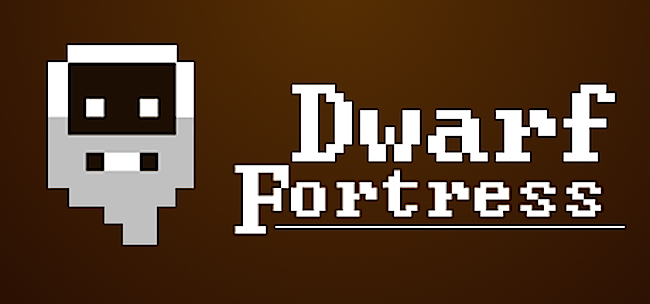
It’s hard to explain on paper what makes Dwarf Fortress so great, but even harder yet to get others to take that dive. It’s hard to learn, sore on the eyes, and will have you constantly questioning your decisions. However, you’ll hit that moment where you’ll begin loving every table flipping moment.
Dwarf Fortress is a free to play indie rogue-like city management game, where you are tasked with the equipping, managing and safety of a group of (hopefully) expanding dwarves.From managing the personalities of the dwarves, to room layout, to rival kingdoms, there always seems to be something to learn from this beast. Rooms appear to have their own internal design system which must have been imported from other games. The also dwarves have personalities which put the Sims to shame. And yet, what keeps you coming back is the need to build that fortress before it’s wiped out by some unforeseen reason or force. With it being free to play, it’s almost a crime that gamers have yet to challenge themselves. Maybe it’s too deep, or perhaps it’s the graphics?
Each game will begin with a randomly generated world, randomly generated regions, a handful of dwarves, and, hopefully, the right combination of skills and equipment. You’ll undoubtedly struggle with many different hardships along the way, and below the lays you’ll find… Well, it’s free to play, why not come in and find out?
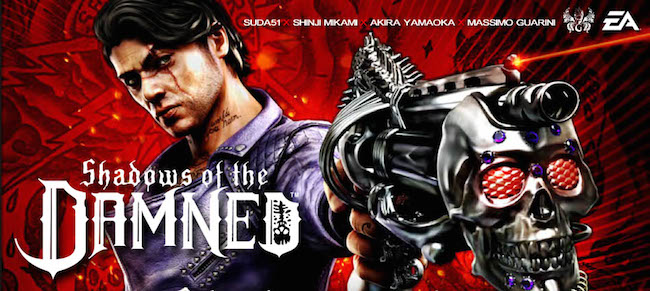
Oh, man! Suda 51, Shinji Makami and Akira Yamaoka – What an incredibly bizarre combination of talent! For those who don’t recognise those names, though, we have the auteur genius behind games such as Killer7 and No More Heroes, the father of Resident Evil, and the famed composer from the Silent Hill series. Yep. You’re in for a treat!
Garcia Hotspur is a demon hunter who doesn’t take sh*t from anyone, and it especially pisses him off when the Lord of Demon’s kidnaps his girlfriend; taunting that he is going to kill her over and over just to show him whose boss. Well, we can’t have that now. Garcia decides to follow the Demon Lord back to the underworld, equipped with his gun/torch/motorcycle combo called Johnson, in order to take him down once and for all. It’s the best B-movie gaming equivalent ever made, and with so many double entendres that it would make a stadium of teenage boys cheer.
It would best be described as a psychological horror-comedy, and for the most part, it succeeds in all those areas very well – you just have to be willing to embrace a lot of dick jokes to appreciate its genius. Putting the themes aside, though, as a game, it’s basically an evolution of the mechanics seen in Resident Evil 4, and I pay that as a massive compliment. It’s surprisingly fun to play and embraces some incredibly unique ideas that work in unison with an outstanding soundtrack. Its a cult classic experience in every way, which just so happens to be constructed around a well designed game. Unlike Resident Evil 6, it knows what it’s meant to be and it’s awesome at it. eBay this game.
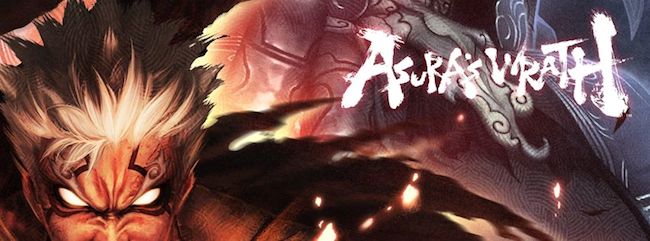
Asura’s Wrath in its essence is an interactive anime, which in terms of gameplay, is very unique and different from traditional means. The game itself is a combination of multiple play styles, ranging from third-person action to rail shooting fun, and by god is it fun! I found it to be a great game because it has a very deep enriching story, and the visual style is just simply amazing. One feature about the game that I absolutely loved was the use of quick-time event and context sensitive button mashing during the use of cutscenes, that, in turn, depending on how well or poorly you executed them, would affect the result of the cutscene.
The story of Asura’s Wrath is based around the pivotal character called “Asura,” of course, who is a demi-god that’s seeking revenge on the pantheon of other demi-gods who betrayed him. Now, this may sound like your traditional God of War story, but rest assured, this is far from it. The Story draws heavy elements of Buddhism and Hinduism, and then throws in a nice dash of good old science fiction. Overall, the game is presented more like an episodic anime television series with very subtle introductory and closing credits at the start and end of each episode. For example, at the end of each episode you are greeted with a brief promo for the next episode which leaves you wanting more.
I highly recommend that anyone who is into the science fiction anime genre to give Asura’s Wrath a try as I don’t think you will not be disappointed. With its unique blend of out of this world gameplay and beautifully rendered/drawn graphics, it will almost certainly leave you on the edge of your seat the entire time.
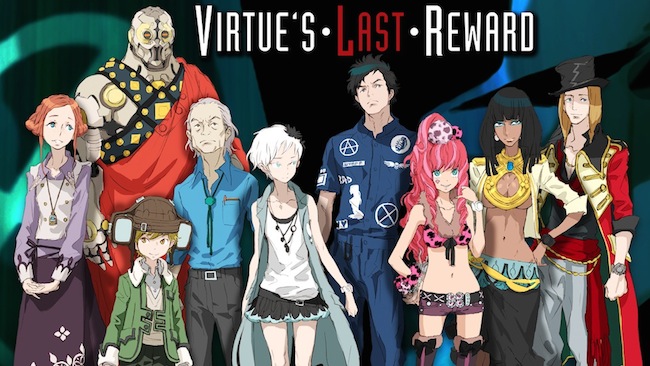
I don’t usually favour handheld games if I can help it, but when surgery forced me to get my sloth on, I was rescued from the clutches of boredom by the 3DS. Earlier last year, I played 999 and found it equal parts confusing, entertaining and chilling. It was more an experience than a game, so when I became bedridden again, I sought out a copy (and burnt a sizable hole in my pocket) of the sequel: Virtue’s Last Reward.
Where the first game strolled through the pastures of WTF, its follow-up built a homestead and invited everyone to stay for the show. Without ruining the mystery of the actual narrative, the most I can say is: whatever you think the big reveals are, you won’t even be close. It follows nine unfortunates, including yourself, as they try to survive a sinister game and discover what is really going on before its too late. The puzzles are deadly and satisfying, when I finally cracked some, but it was the 30+ hours I spent tearing apart the story that makes this awesome. It required jumping through timelines and piecing together one of the most random yet intriguing tales I’ve enjoyed in a long time. If you like twisted realities, puzzles, and text-heavy games then hunt down a copy of Virtue’s Last Reward. You don’t need to play 999 first, but the background helps, as much as anything can help a time-jumping, sadistic-game escaping hero.
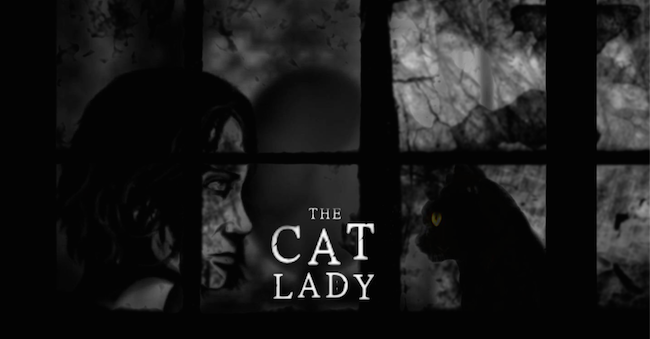
When I first came across The Cat Lady, I was also occasionally referred to as a crazy cat man, so, of course, the title sang out to me. Being hungry for a story driven point-and-click adventure, I was already curious, but certainly not prepared for the emotional tidal wave that was to follow. The Cat Lady is a horror-tinged game that deals with extremely heavy themes such as depression, isolation, despair and suicide, so it’s certainly not for everyone.
The story follows Susan Ashworth, a lonely, depressed woman that plays piano for the neighbourhood cats (to the chagrin of her neighbours) who commits suicide. She then awakes in some kind of afterlife where she meets The Queen of Maggots who offers her a deal: rid the world of “parasites” (psychopaths) and then she can finally find peace. The other part of the deal is immortality – forcing Susan to face her own demons, as well as those she’s been sent to kill. Susan is, at first, incredibly difficult to become attached to as she is so pitiful and downcast, seemingly bent on denying herself any happiness. Her characterisation throughout the game is deep and genuine and reflects the difficulty people living with depression have with connecting with other people as well as the same difficulty people have with trying to connect with someone with depression. The introduction of Mitzi into Susan’s life (as in Mitzi barges her way in) marks a turning point in her development and the friendship that is slowly, painfully eked out is genuine and heart-warming. It’s these moments, rather than the horror elements (which are thrilling and disturbing in their own right) that standout and form the basis for The Cat Lady, and it’s why the game holds a special place in my heart.

This game was actually sitting in my “shame pile” until very recently. You know the shame pile. We all have one…
Monaco is a game that generated a lot of buzz upon first release, but, like me, you might have been busy with too many other things to bother with this game. Besides, it was just another low-fidelity graphic “Indie” game, and by the time it was released there were already plenty of those, and did I really want to have a go at yet another?
Well, I recently dusted this one off with some mates (that is to say, installed it because it was on that other, more shameful pile of games you own that aren’t even installed) because, why not? And you know what? It’s an absolutely entertaining game to play with your friends. If you’re playing on PC, I suggest you use voice comms for full comical effect. However, this would be a great “couch co-op” party game on your 360 (get it on XBLA).
There’s a surprising amount of detail in the gameplay. It starts off fairly simple, but each new level introduces new mechanics to help you sneak around and accomplish your goals. Or not. That’s the cleverness of this game. The game lets you play carefully with meticulous planning and execution, or in more liberal fashion, running around making a lot of noise. This latter approach certainly leads to much hilarity as you and your mates run around the levels trying to shake off the guards, running past each other trying to lose your pursuers, but ending up collecting more and more guards to the train as you go. This game really is a lot of fun with friends and I highly recommend it!










